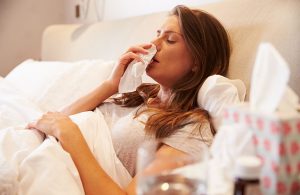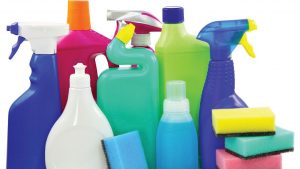If you’ve ever used sprays and detergents to clean your kitchen or bathroom and then started to cough or wheeze, it could be a sign that the chemicals in the products are damaging your lungs
For most of us, cleaning our home is a household chore we’d rather not do – and now there may be good reason to avoid it…
If you’ve ever used sprays and detergents to clean your kitchen or bathroom and then started to cough or wheeze, it could be a sign that the chemicals in the products are damaging your lungs.
New research carried out in Norway, and released as part of the Healthy Lungs for Life campaign, has revealed that cleaning, both in the workplace and in the home, can actually be doing you harm
by leading to a greater risk of chronic obstructive pulmonary disease (COPD), which includes chronic bronchitis and emphysema.
The study, which followed 5,000 women over 20 years, found that professional cleaners have a 17% greater decline in
lung function compared to the average woman.
But women who regularly clean their homes are also in danger – experiencing a 14% greater decrease in lung function over 20 years, due to exposure to chemical agents, such as ammonia, which irritate the airways, and other substances that can cause allergic reactions in the airways.
Oistein Svanes, from the University of Bergen in Norway, conducted the study, which was the first to monitor the long-term consequences of exposure to cleaning agents.
If you’ve ever used sprays and detergents to clean your kitchen or bathroom and then started to cough or wheeze, it could be a sign that the chemicals in the products are damaging your lungs ( Image:
Getty)
He says: “Cleaning your home is a regular activity, and that’s why this concerns so many people.
“We need to start being much more aware of the chemicals we’re releasing into the air we breathe when we use things like cleaning spray.”
Dr Gareth Walters, of the West Midlands NHS Regional Occupational Lung Disease Service, adds: “It is a concern because it’s the first evidence that there’s some long-term damage to lungs due to exposure to cleaning agents.
“Moreover, it’s damage done not just to occupational cleaners, but also relates to cleaning done in the home.”
And he believes the rise in superbugs, such as MRSA, could be to blame.
Dr Walters explains: “Some household cleaners are now using the same substances used in industrial cleaners, and I think this is a response to reports of superbugs in hospitals 10 or 15 years ago. I think they have become stronger.
“I’m sure there’s a commercial reason – if you can sell your product as killing all known germs, it’s more likely to sell than one that claims to kill only 70% of germs.
“But the flip side of that is they become more potent and potentially cause disease.”
While Dr Walters says there is less risk of developing COPD from domestic cleaning – unless exposed to large amounts of the chemicals on a daily
basis over a long period of time – his team has seen a big increase in the past five years in cases of asthma that are linked to exposure to a variety of cleaning products.
He says: “We do see a few people with domestic-related problems but we are mainly seeing people where cleaning agents have been implicated in their job. It’s largely healthcare workers, professional cleaners and people who work in institutions that need cleaning regularly.
“But even if you work in an office and are not involved in cleaning, some of those cleaning agents are in the air when you come into work.”
How to tell if you’re affected
Symptoms can include coughing, a tightness in the chest, breathlessness during minimal exertion and wheezing when exposed to the cleaning agent. Anyone who experiences any of these at home or in the workplace should talk to their GP.
“You may find your symptoms improve when you’re away from the exposure, such as being away from work, but you should still get them checked,” says Dr Walters. “In addition to cigarette smoking, COPD can actually be caused by uncontrolled asthma over a number of years.
“If the cause of the asthma persists or the presence of symptoms is not
recognised, then any drop in lung function can become permanent over time.”
What can you do?
Dr Walters says: “I would recommend people always look at the label and know exactly what they’re exposing themselves to before buying products.
“People should follow instructions carefully and use at the correct concentration so they are adequately diluted. It’s also important that the room they are cleaning is well-ventilated.
“Avoid using warm water if the product needs mixing because warm water evaporates and you will breathe in the fumes. And, finally, try to use cleaners that can be poured directly on to cloths or surfaces rather than sprayed as a mist or aerosol.”
The risky chemicals to avoid
There are many ingredients that can cause asthma if you’re using them in the home, though not all asthmatics will be affected. Some of the more common are:
- Methylisothiazolinone (MI/MIT) – found in kitchen and floor sprays, as well as in some over-the-counter beauty products.
- Benzalkonium chloride (quaternary ammonium compound) – typically used as a disinfectant in household cleaners for floors and hard services.
- Chlorine-based agents (sodium hypochlorite) – used as the active ingredient in bleach.
- Some scents – within cleaning agents e.g. limonene, which gives some products their citrus smell.
- Isothiazolinones – used in some washing-up liquids and some laundry washing liquids.
Ways to reduce your exposure
The Healthy Lungs for Life campaign recommends you:
- Check the ingredients and avoid cleaning products that will put you at risk.
- Follow label instructions about the safe use of chemicals.
- Use wipes not sprays so that there are fewer airborne particulates to breathe in.
- Open doors and windows during and after cleaning to ensure good ventilation.
- If you have any concerns about the impact of chemicals in the home on
your lungs, go to your GP and get your lungs tested.
- The Healthy Lungs for Life campaign, which raises awareness of the importance of healthy lungs, will be holding free public lung-function testing, starting in London’s Trafalgar Square, September 2-3. Visit healthylungsforlife.org for details.






